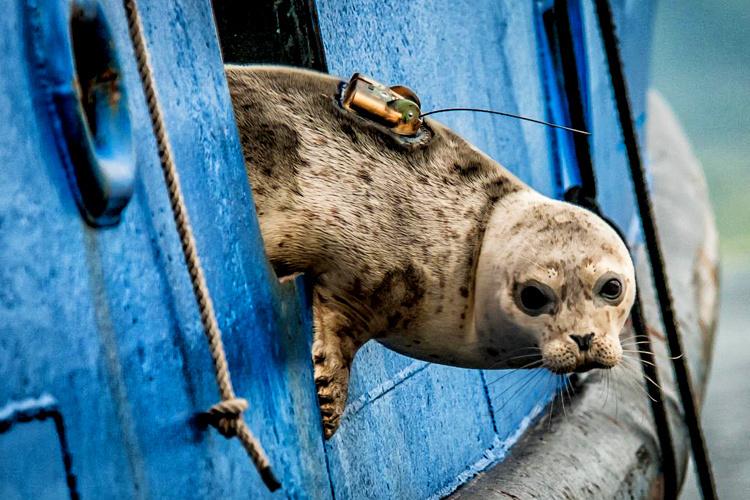Estimating Harbor Seal Abundance and Distribution
We fly over coastal and glacial harbor seal habitat in research aircraft, such as the NOAA Twin Otter, and photograph seals hauled out on shore or on ice. Back in the office, we review the photos and count seals visible in the images. The counts are only one part of the story. Not all seals are present on the haul-out site during surveys, so we need to account for seals that are in the water, where we cannot reliably detect them. We use haul-out behavior records from satellite-linked tagged individual seals to help us fill in the gaps. The image counts are coupled with haul-out behavior data using a statistical model that estimates harbor seal abundance and trends.

Harbor seals hauled out on a sand bar.
Tracking Harbor Seals Movement and Behavior

Harbor seals hauled out on an ice floe in a glacial fjord.
Satellite-telemetry studies—where we collect information on the health, condition, diet, and genetics of individual seals that are monitored with satellite-linked tags (also known as bio-loggers)—are effective for gathering the data needed to better understand harbor seal ecology, behavior, and population health. Tagging studies are also important for determining habitat used by harbor seals: where they go when they are feeding, how far they travel from haul-out locations, and what types of habitat they use.
Understanding the Impacts of Vessel Disturbance on Harbor Seals
There has been a 10-fold increase in tour ship traffic over the last three decades in Alaska’s glacial fjords. Our research helps NOAA Fisheries resource managers determine safe vessel approach limits and enact and enforce regulations to better protect harbor seal pupping and molting habitats.
In one study we tagged harbor seals to examine individual behaviors of mothers and pups. Using these data, we developed methods to describe behavioral and energetic responses to disturbance by vessels and to assess long-term trends in abundance and distribution of disturbed populations. With this information, we are better able to understand the likely impacts of vessel disturbance on ice-associated harbor seals in glacial fjords.
Collaborating with Local Communities on Harbor Seal Research
To conserve and provide stewardship of marine mammal populations that are vital to the subsistence lifestyle of Alaska Native people, NOAA Fisheries has formed partnerships with Alaska Native communities. Subsistence hunters have extensive knowledge of harbor seals and have contributed traditional knowledge to scientific research and management through interviews, contributions of biological samples, and participation in scientific field projects.
Additional Resources
- Marine Mammal Stock Assessment Reports
- Harbor Seal Telemetry Study in the Aleutian Islands in 2014
- Harbor Seal Research in the Aleutian Islands in 2015
- Alaska Harbor Seal Approach Guidelines in Glacial Fjords 2015
- Studies of Harbor Seals Using Glacial Ice in Disenchantment Bay, Alaska, 2016-2017
- Harbor Seal Survey in Alaska
- Harbor Seals in Iliamna Lake
- Co-Management of Marine Mammals in Alaska
- Harbor Seal Research
- Harbor Seal Data
- Harbor Seal Maps
Contact

